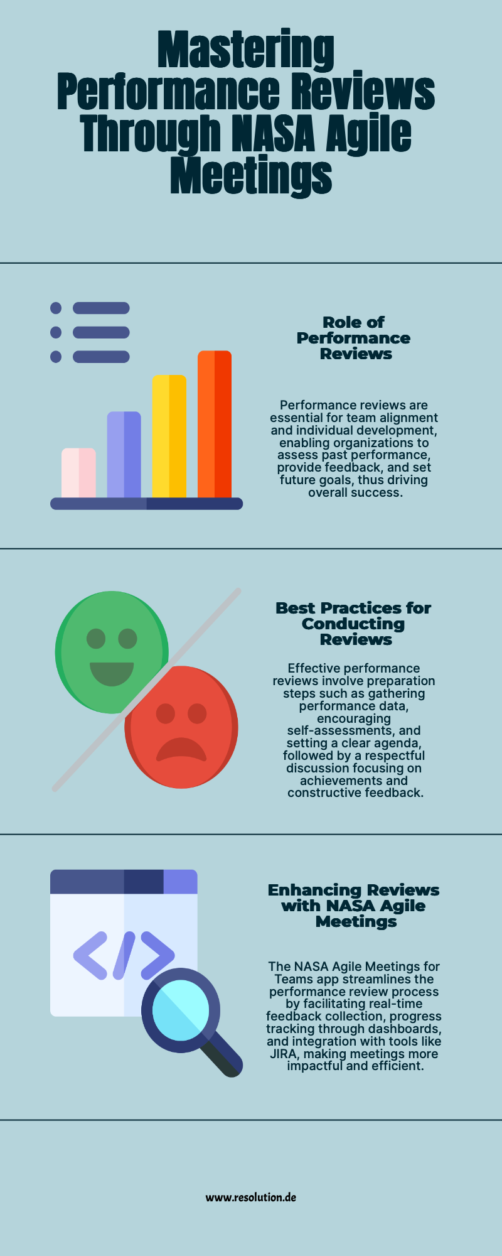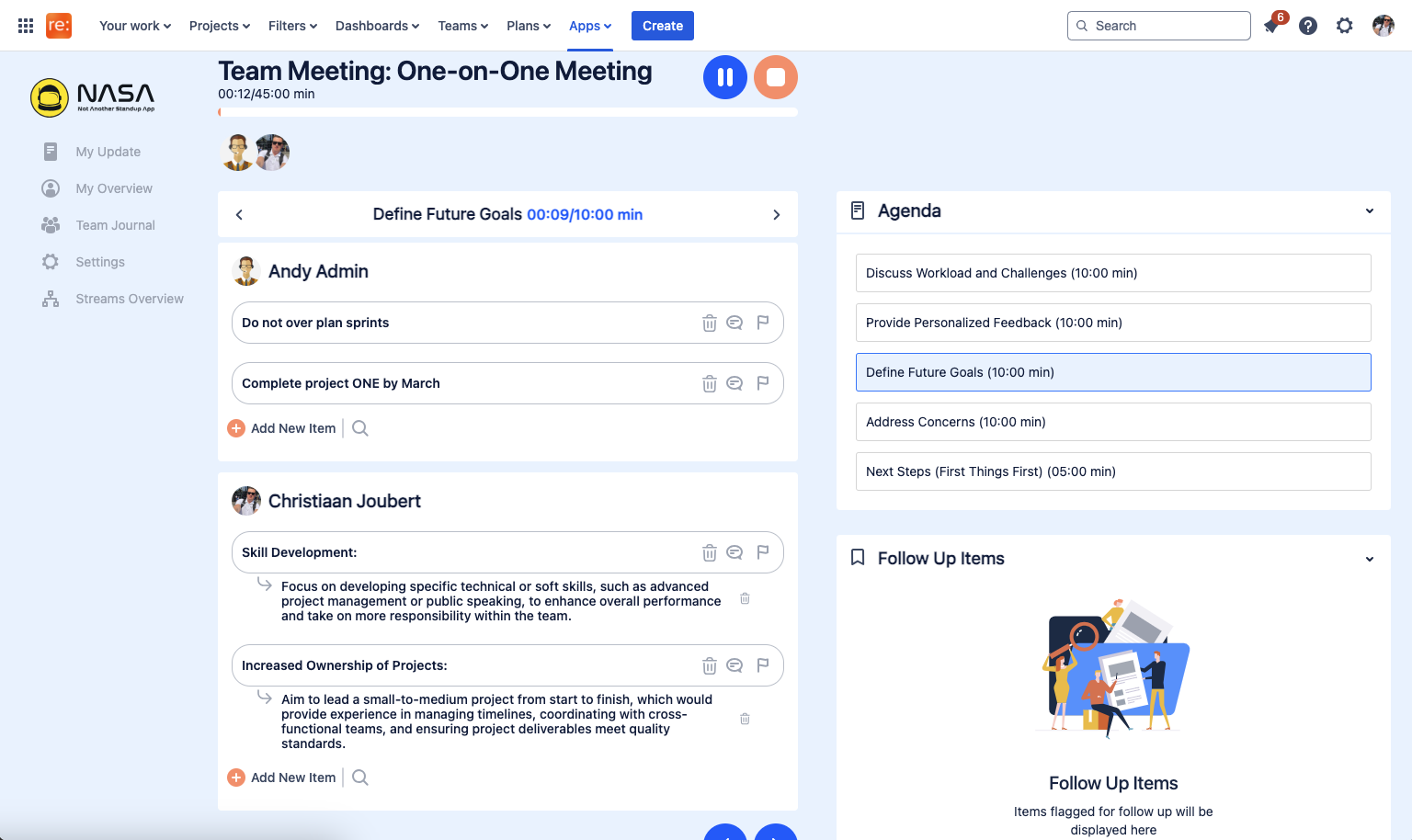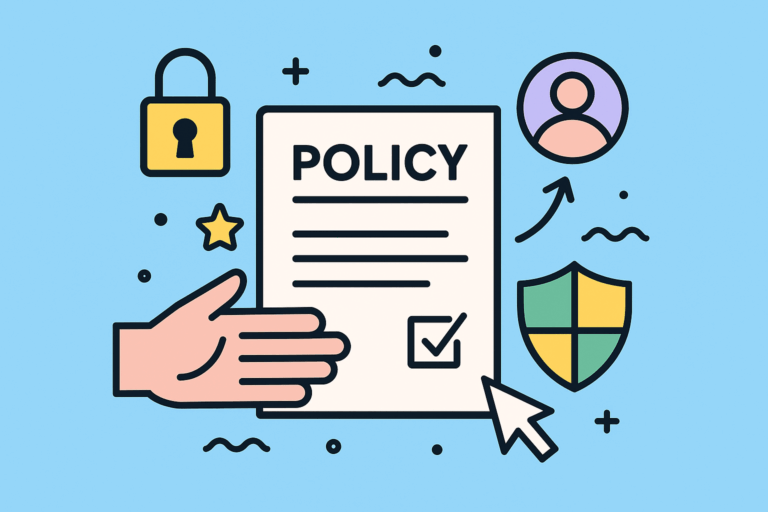Performance reviews are more than just an HR exercise—they are pivotal moments that shape team development, drive organizational success, and empower individuals to excel in their roles. These structured meetings allow teams to evaluate past performance, deliver constructive feedback, and set actionable goals for the future.
Despite their significance, performance reviews can often feel overwhelming. The stakes are high, and navigating the balance between motivation and constructive critique requires skill. To address these challenges, leveraging tools like NASA Agile Meetings for Teams ensures a streamlined, effective performance review process, elevating team collaboration and individual growth.
This blog will guide you through mastering annual performance reviews, explore best practices, and showcase how the NASA Agile Meetings for Teams app is a game-changer in this field.
Key Takeaways
The role of performance review meetings in fostering team alignment and individual growth.
Best practices to prepare, conduct, and follow up on performance reviews.
How NASA Agile Meetings for Teams enhances performance review meetings through data-driven insights and seamless integration.
Understanding Performance Reviews
Annual performance review meetings are formal or semi-formal discussions where managers and team members reflect on past performance, assess strengths and weaknesses, and set future objectives. These sessions typically address three critical questions:
What has been accomplished? Evaluating past goals and achievements.
Where can we improve? Identifying growth opportunities and challenges.
What’s next? Aligning on objectives and developmental paths for the future.
The collaborative nature of these meetings is essential. Managers and team members engage in open communication, fostering a shared understanding of expectations, achievements, and areas for improvement.
The Importance of Performance Reviews
Performance reviews play a crucial role in personal and organizational development:
Employee Development: Tailored feedback and actionable goals empower individuals to grow their skills and reach their potential.
Organizational Alignment: Regular reviews ensure that individual objectives align with broader team and company goals.
Retention: Recognizing achievements and providing growth opportunities improves morale and reduces turnover.
However, neglecting these reviews can lead to misalignment, diminished productivity, and attrition. For example, without clear feedback, high-performing employees might feel undervalued, while underperformers may struggle to improve due to a lack of direction.
Key Objectives of a Performance Reviews
Effective performance reviews achieve the following goals:
Evaluate Past Performance: Assessing both successes and challenges using clear metrics and qualitative feedback.
Provide Constructive Feedback: Offering insights in a way that motivates improvement rather than discouraging effort.
Set Future Objectives: Defining achievable, meaningful goals that align with team and organizational priorities.
Achieving these objectives ensures that teams operate cohesively, individuals feel supported, and efforts contribute to broader success.

Who Should Attend a Performance Review Meeting?
The two primary participants are:
Managers: Responsible for preparing metrics, delivering feedback, and setting actionable objectives.
Individual Team Members: Expected to participate actively, offering self-assessments and collaborating on development plans.
Their collaboration is vital. Managers provide insights and resources, while team members bring self-reflection and career aspirations to the discussion.
Roles and Responsibilities
In performance reviews:
Managers:
Analyze performance data and prepare feedback.
Facilitate discussions that are constructive and goal-oriented.
Support team members in overcoming challenges and achieving objectives.
Team Members:
Reflect on their performance and areas for growth.
Share insights about their experiences and career goals.
Collaborate on actionable plans for the next review period.
This dual responsibility fosters a balanced, productive review process.
Preparation Steps
Preparation is the cornerstone of a successful performance review. Key steps include:
Gathering Performance Data:
Use tools like NASA Agile Meetings for Teams to compile metrics, track progress, and review feedback.
Encouraging Self-Assessments:
Empower team members to reflect on their achievements and challenges.
Setting an Agenda:
Outline discussion points, including strengths, growth areas, and future objectives.
These steps ensure that reviews are data-driven, focused, and productive.
How to Conduct an Effective Performance Review Meeting
Follow this step-by-step guide for impactful reviews:
Start Positively:
Recognize accomplishments to set a constructive tone.
Discuss Key Metrics:
Present data and insights, focusing on both successes and areas for improvement.
Provide Constructive Feedback:
Frame critiques as opportunities for growth, using specific examples.
Collaborate on Goals:
Work with team members to set clear, actionable objectives for the next period.
Summarize and Follow-Up:
Conclude with a recap of the discussion and a plan for ongoing support.
By fostering a respectful, goal-oriented environment, these meetings can inspire continuous improvement.
How NASA Agile Meetings for Teams Enhances Performance Reviews
NASA Agile Meetings for Teams offers transformative tools to optimize performance reviews:
Feedback Collection:
Streamline input from peers, managers, and stakeholders, ensuring a comprehensive view of performance.
Progress Tracking:
Use dashboards to visualize individual and team progress against objectives.
Real-Time Collaboration:
Leverage tools for interactive discussions, fostering engagement and alignment.
Integration with JIRA:
Seamlessly incorporate task data and project updates, enriching discussions with actionable insights.
These features reduce administrative overhead, enhance communication, and enable data-driven decision-making.

Summary
Performance reviews are essential for individual development and team success. By preparing effectively, fostering open communication, and leveraging tools like NASA Agile Meetings for Teams, organizations can transform these meetings into powerful drivers of growth and alignment.
The app’s innovative features—feedback collection, progress tracking, and integration with tools like JIRA—simplify the review process, empowering teams to achieve their goals with precision and efficiency.
Ready to elevate your performance review process? Explore how NASA Agile Meetings for Teams can transform your approach:
Schedule a Demo: See the app in action and discover its capabilities.
Visit the Product Page: Learn more about features and benefits.
Download from the Atlassian Marketplace: Get started today and experience the difference.
Take the first step toward performance review mastery and unlock your team’s potential.
Frequently Asked Questions
How often should performance reviews be conducted?
Performance reviews are typically conducted quarterly or semi-annually, depending on organizational needs.
What if an employee reacts defensively to feedback?
Address concerns empathetically, focusing on specific examples and actionable suggestions.
Can performance reviews be conducted remotely?
Yes, with tools like NASA Agile Meetings for Teams, remote reviews are seamless and productive.
How does the app support goal tracking?
The app provides dashboards to visualize progress, ensuring alignment with team and organizational objectives.
Is NASA Agile Meetings for Teams suitable for non-Agile teams?
Absolutely! While designed for Agile practices, the app’s versatile features benefit any team seeking efficient performance management.
With these insights and tools, you’re equipped to revolutionize your performance review process. Start today, and lead your team to unparalleled success.
Top Performance Review Template: Enhance Feedback Efficiency Today
Understanding Performance Reviews
What are Performance Reviews?
Performance reviews are formal, structured processes where an employee’s past performances are evaluated.
It involves setting expectations and goals for the future that align with the employee’s career progression and the organization’s long-term objectives.
The purpose of performance reviews is to offer constructive feedback, show employees where they can improve, and help them develop in their careers.
The Performance Review Process
Key Components of Effective Performance Reviews
A clear understanding of the organization’s goals and objectives.
A standardized rating scale to evaluate performance.
A review period that specifies the time frame being evaluated.
A discussion of the employee’s strengths, weaknesses, and areas for improvement.
A plan for future development and growth.
Types of Performance Review Templates
Annual Performance Review Template
An annual performance review template is used to evaluate an employee’s performance over a 12-month period.
It typically includes a review of the employee’s job performance, goals, and objectives.
It also includes a rating system and space for comments and feedback.
Quarterly and Simple Performance Review Templates
Quarterly performance review templates are used to evaluate an employee’s performance every 3-4 months.
Simple performance review templates are used to provide a concise and straightforward evaluation of an employee’s performance.
Both types of templates can be used to provide regular feedback and coaching to employees.
Benefits of Using Performance Review Templates
Consistency and fairness in the evaluation process.
Efficiency and time-saving in the review process.
Improved communication and feedback between managers and employees.
Enhanced employee development and growth.
Better alignment with organizational goals and objectives.
Preparing for Performance Reviews
How to Prepare for a Performance Review as an Employee
Review your job description and performance goals.
Gather feedback from colleagues and supervisors.
Prepare examples of your accomplishments and challenges.
Think about your career goals and development needs.
How to Deliver a Performance Review as a Manager
Prepare a clear and concise evaluation of the employee’s performance.
Focus on specific behaviors and actions rather than personality traits.
Provide constructive feedback and suggestions for improvement.
Listen actively and respond to employee concerns and questions.
Best Practices for Performance Reviews
Creating Effective Employee Evaluation Forms
Use a standardized rating scale to evaluate performance.
Include a review period that specifies the time frame being evaluated.
Provide space for comments and feedback.
Make sure the form is easy to understand and use.
Legal Considerations
Ensure that the evaluation process is fair and unbiased.
Avoid discriminatory language or behavior.
Keep records of all evaluations and feedback.
FAQs
What is the Purpose of Performance Reviews?
The purpose of performance reviews is to evaluate an employee’s job performance, provide feedback and coaching, and set goals for future development and growth.
Conclusion
Performance reviews are an essential part of the employee development process.
Using a performance review template can help streamline the review process and provide consistent and fair evaluations.
By following best practices and considering legal implications, managers can create effective performance reviews that enhance employee growth and development.




